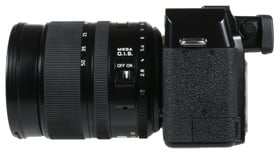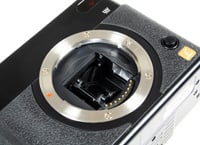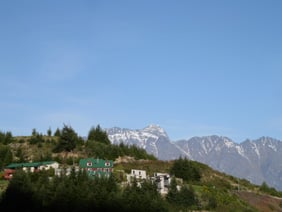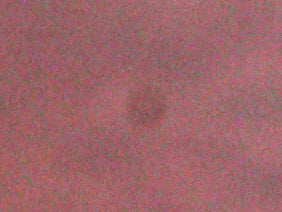Panasonic Lumix DMC-L1
-
-
Written by Gordon Laing
Panasonic Lumix DMC-L1 anti dust
Panasonic Lumix L1 features
Lenses and viewfinder / Screen and menus / Sensor and processing / Anti dust
|
The Lumix L1 shares the same SuperSonic Wave Filter (SSWF) as the Olympus E-Series DSLRs for tackling the problem of dust on the sensor. This is another big selling point for the L1 as the SSWF is widely regarded as the most effective anti-dust system developed so far. As such we were keen to put it to the test.
 |
At this point it’s important to note the evaluation of anti-dust dust systems can never be as controlled or consistent as other tests. After all, there’s no way of counting the number or type of dust particles which currently lie within a body, nor any way to introduce a consistent number of test particles for it to subsequently get rid off. As such it’s impossible to conclude one system is categorically better than another at eliminating dust.
Just because something can’t be scientifically measured though, doesn’t mean it should be glossed-over or ignored. Dust is the number-one complaint for many DSLR owners and anti-dust systems have become some of the most talked-about and desirable features in new bodies. As such even anecdotal evidence is valuable and by gathering it from a number of sources over time we can build up a picture of how effective, or ineffective a system performs. That’s our belief at Camera Labs, so for the record here’s what we found.
First things first: the Lumix L1 performs its SSWF anti-dust process every time the camera’s switched on and there’s no way to override it. Unlike the Olympus DSLRs though, there’s no animation advertising the process taking place. The L1 just starts up without any fuss, and also appears to do so quite quickly.
According to Panasonic’s engineers, the L1’s SSWF filter vibrates at 30KHz for 0.25 seconds, and it’s ready for action pretty much straight afterwards – indeed we managed to go from a cold power up to focusing and firing-off a first shot in just over a second. This is in some contrast to the often infuriating period the Olympus DSLRs force you to wait as they power-up, even when their SSWF animation is disabled. At first we believed this delay was entirely due to the cleaning process, but Panasonic claims the L1 uses exactly the same system. We are currently investigating this and will report back with any updates, but the bottom line is the L1 doesn’t keep you waiting for long.
 |
Now onto the actual effectiveness of the system. During our initial test period we swapped lenses several times, but were quite careful when doing so. Our first sets of images showed no evidence of dust. We then took less care when swapping lenses, leaving the body open without a cap for several seconds at a time, but still no evidence of dust.
So far so good, but we wanted to really see what the L1 was capable of. So we removed the lens and left the body open for a whole ten minutes. We then took it outside and left it open for a further five minutes. We don’t believe anyone would actually do this in normal use, but wanted to push the L1 to its limits.
The best conditions for revealing dust are shots of plain white areas, like walls or cardboard photographed at close range with the focus manually set to infinity and the aperture fully closed. So after leaving the body opened we switched the camera off and on, then took a photo under the conditions described and carefully examined it at 100% using Photoshop on a calibrated Eizo CG210 monitor. At last we found the tell-tale signs of a single dust mark, but it was considerably fainter than those you’d find on other DSLRs – indeed it was virtually invisible on the CG210, and impossible to spot on standard PC monitors. To see if we could show it on a natural image we photographed an outdoor scene with blue sky positioned where we knew the dust mark resided (roughly halfway across the image near the top).
Panasonic Lumix DMC L1 dust example | ||
 |  | |
| Full frame, reduced in size to 282×212 pixels | 100% crop measuring 282×212 pixels | |
We’ve included a shrunken image of the full shot above alongside a 100% crop of the area showing the dust mark – it’s in the middle (honestly!), but you’ll need a good screen to spot it. So in an almost CSI-style approach we’ve retaken this crop from a white-board shot and shown it below, alongside a version with the levels severely compressed in Photoshop until the mark reveals itself.
Panasonic Lumix DMC L1 dust example 2 | ||
 |  | |
| 100% crop measuring 282×212 pixels | 100% crop measuring 282×212 pixels with Levels | |
Scientific? Not really. Repeatable? Hardly. But effective? We’d say so. We may have managed to find a dust mark on the L1, but only under extreme conditions which it’s fair to say would never occur under normal use, and even then only on areas of flat colour at an aperture of f22 with the help of a high quality monitor and Photoshop’s Levels control.
Interestingly though, the L1’s resistance to dust could be as much to do with the distance between the SSWF filter and sensor as it is with the actual vibrating process itself. While rival anti-dust approaches tend to focus on the low pass filter which is close to the sensor’s surface, the SSWF in the L1 is a relatively massive 7mm away. Consequently any dust which may lay on it is generally beyond the optical depth-of-field. Indeed our single dust mark essentially disappeared when the aperture was opened even a stop beyond f22.
Ultimately it’s fair to say the L1, in our experience anyway, was either highly efficient at getting rid of dust or simply oblivious to most of it in general use. By additionally not compromising the startup time, we believe the L1 comfortably takes the lead in the battle against dust.




